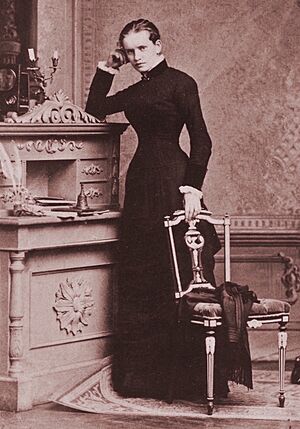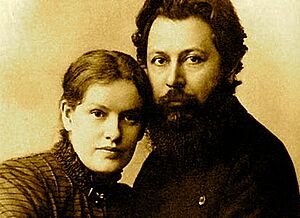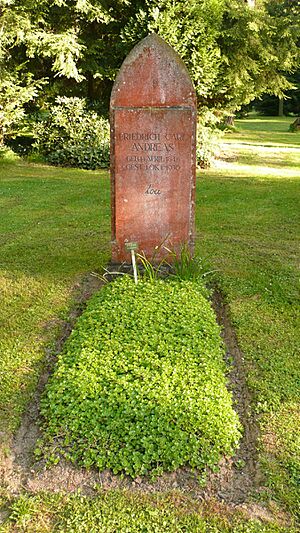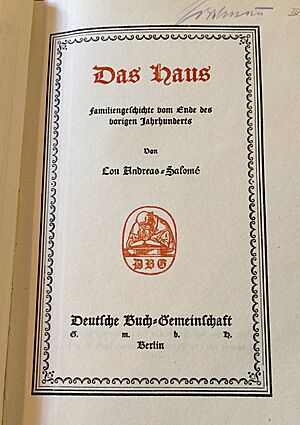Lou Andreas-Salomé facts for kids
Quick facts for kids
Lou Andreas-Salomé
|
|
|---|---|
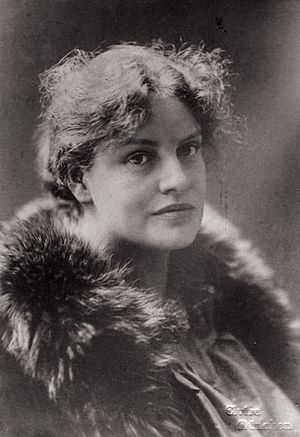
Lou Andreas-Salomé in 1897
|
|
| Born | 12 February 1861 |
| Died | 5 February 1937 (aged 75) Göttingen, Germany
|
| Nationality | German |
Lou Andreas-Salomé (born February 12, 1861 – died February 5, 1937) was a Russian-born writer and a pioneer in psychoanalysis. She came from a French Huguenot-German family and traveled widely. Lou was known for her many interests, which led her to become friends with important thinkers. These included Friedrich Nietzsche, Sigmund Freud, Paul Rée, and Rainer Maria Rilke.
Contents
Life Story
Early Years and Education
Lou Salomé was born in Saint Petersburg, Russia. Her parents were Gustav Ludwig von Salomé and Louise von Salomé. She was their only daughter and had five older brothers. Lou grew up in a wealthy family that valued culture and learning. All the children learned Russian, German, and French. Lou was even allowed to attend her brothers' classes, which was unusual for girls at the time.
Her family was very religious, but Lou questioned their strict Protestant church. At age 16, she officially left the church. However, she remained very interested in ideas about philosophy, literature, and religion.
Lou was especially fascinated by the sermons of Hendrik Gillot, a Dutch pastor. Gillot, who was 25 years older than her, became her teacher. They studied many subjects together, including theology, philosophy, world religions, and French and German literature. This wide range of study helped her prepare for meeting famous thinkers later in life.
After her father passed away in 1879, Lou and her mother went to Zürich, Switzerland. Lou wanted to attend university there as a "guest student." The University of Zurich was one of the few schools that accepted female students. During her year there, Lou studied philosophy and theology. She had some health problems, so in 1882, she and her mother traveled to Rome for a warmer climate.
Friendships with Rée and Nietzsche

In Rome, when Lou was 21, she met the writer Paul Rée at a literary gathering. Rée suggested they get married, but Lou had a different idea. She proposed that they live and study together as friends, like 'brother and sister,' and invite another man to join them to form an academic group. Rée liked this idea and suggested his friend Friedrich Nietzsche.
Lou and Nietzsche met in Rome in April 1882. Nietzsche was very impressed with Lou. He asked Rée to propose marriage to Lou for him, but she said no. She was interested in Nietzsche as a friend, not a husband. Still, Nietzsche was happy to join Rée and Lou as they traveled through Switzerland and Italy, planning their academic group.
Nietzsche's sister, Elisabeth, did not like Lou and tried to separate them. The idea for their academic group, which they called "Winterplan," was to set up in an old monastery. But they couldn't find a suitable place, so the plan was eventually dropped.
After spending some weeks together in Leipzig in October 1882, Rée and Lou went their separate ways from Nietzsche. Nietzsche later wrote a lot about this time. Lou later wrote a book about Nietzsche's personality and ideas called Friedrich Nietzsche in his Works (1894).
Marriage and Other Connections
Lou and Paul Rée lived together in Berlin for some years. Later, Lou married Friedrich Carl Andreas, a scholar who studied languages. They were married from 1887 until his death in 1930.
Throughout her life, Lou had many close friendships and exchanged letters with important people. These included the German politician Georg Ledebour and the Austrian poet Rainer Maria Rilke. She wrote a book about Rilke. She also had intellectual connections with psychoanalysts like Sigmund Freud and Victor Tausk. Freud greatly admired Lou's deep understanding of people. He believed she understood others better than they understood themselves. They often wrote letters to each other.
Lou's book about Nietzsche, Friedrich Nietzsche in his Works, was seen as very insightful. Anna Freud, Sigmund Freud's daughter, believed this book showed ideas similar to psychoanalysis even before it became a field of study.
Meeting Rainer Maria Rilke
In May 1897, Lou met Rainer Maria Rilke in Munich. She was 36, and he was 20. Lou had already published successful works, including Im Kampf um Gott, which explored the problem of losing faith.
Lou became a very important person in Rilke's life. In 1899 and 1900, Lou traveled to Russia. The second time, Rilke went with her. She even changed his first name from René to Rainer. She taught him Russian and introduced him to the works of famous Russian writers like Leo Tolstoy and Aleksandr Pushkin. She also introduced him to artists and supporters of the arts. Lou remained Rilke's advisor, trusted friend, and inspiration throughout his adult life. Their close friendship continued until Rilke's death. In 1937, Sigmund Freud said that Lou was "both the muse and the attentive mother of the great poet."
Later Life and Passing
By 1930, Lou's health was declining. She had a heart condition and diabetes and needed hospital treatment several times. Her husband, Friedrich Carl Andreas, visited her daily during a long hospital stay. This brought them very close after many years of marriage. Friedrich Carl Andreas passed away from cancer in 1930. Lou herself had a difficult cancer operation in 1935. At 74, she stopped working as a psychoanalyst.
Lou Andreas-Salomé died peacefully in her sleep on February 5, 1937, in Göttingen, Germany. She was buried in her husband's grave in Göttingen. The city remembers her with a memorial plaque, a street named after her (Lou-Andreas-Salomé-Weg), and an institute for psychoanalysis named in her honor.
A few days before she died, the Gestapo, the secret police of Nazi Germany, took away her library. This happened because she was a colleague of Sigmund Freud, and her work was seen as "a Jewish science." She also owned many books by Jewish authors, which the Nazis did not approve of.
Her Writings
Lou Andreas-Salomé was a very productive writer. She wrote fiction, literary criticism, and essays on religion, philosophy, and psychology. Her works are still being published today. She even wrote a poem called "Hymn to Life" that impressed Nietzsche so much he set it to music.
Lou was one of the first women to become a psychoanalyst. She wrote more than a dozen novels and novellas, including Im Kampf um Gott, Ruth, and Das Haus. She also wrote non-fiction studies, such as a book about Ibsen's female characters (1892) and her book on Nietzsche (1894).
After Rilke's death in 1926, Lou edited a book of memories about him. Another important work is her Lebensrückblick (Looking Back at Life), which she wrote in her final years. In these memoirs, published after her death, she shared deep thoughts about her beliefs and her many relationships.
Whoever reaches into a rosebush may seize a handful of flowers; but no matter how many one holds, it's only a small portion of the whole. Nevertheless, a handful is enough to experience the nature of the flowers. Only if we refuse to reach into the bush, because we can't possibly seize all the flowers at once, or if we spread out our handful of roses as if it were the whole of the bush itself—only then does it bloom apart from us, unknown to us, and we are left alone.
In Books and Movies
Lou Andreas-Salomé's life and relationships have inspired many fictional stories. She appears as a character in several novels, including Irvin Yalom's When Nietzsche Wept and Lance Olsen's Nietzsche's Kisses.
She is also a character in plays, such as Sabina Berman's Feliz nuevo siglo, Doktor Freud (Freud Skating).
Lou Andreas-Salomé has been shown in films too. In Liliana Cavani's movie Beyond Good and Evil, she is played by Dominique Sanda. In the film version of When Nietzsche Wept, she is played by Katheryn Winnick.
An opera about her, Lou Salome, was created by Giuseppe Sinopoli and first performed in 1981. More recently, a German movie titled Lou Andreas-Salomé, The Audacity to be Free was released in 2016, telling her story.
Images for kids
See also
 In Spanish: Lou Andreas-Salomé para niños
In Spanish: Lou Andreas-Salomé para niños


